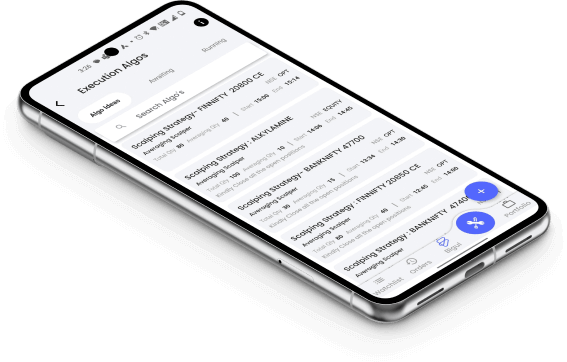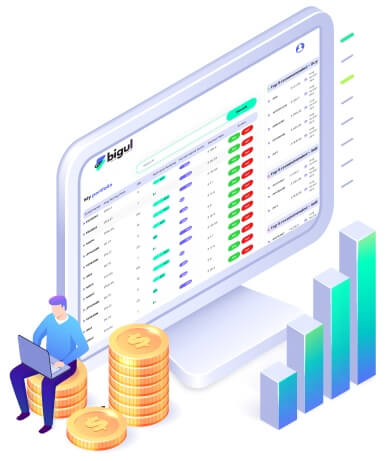Open an Account & Start Algo Trading Today!
- Flat Rs 18 brokerage
- No Cost Algo Trading
- Trade from Chart
- 30+ Indicators
- Stock SIP
- Smart Case
- Bigul Option Chain
- 300+ Pre Defined Market Watch
- IPOs
- Basket Order
Difference Between Margin Trading and Leverage
In the finance field, two terms often tossed around are "margin trading" and "leverage." But what do they really mean? Margin trading involves borrowing money to increase your investment, while leverage is about using borrowed funds to increase your investment exposure. The key here is understanding the difference between the two.
This knowledge is crucial for any investor, as it shapes how you approach the market, manage risks, and potentially reap rewards. In this article, we'll delve into the definitions of margin trading and leverage, unraveling the importance of distinguishing between these financial strategies.
What is Margin Trading?
Margin trading is like borrowing money to buy more stocks or investments than you can afford with your own cash. It's like getting a loan from your broker to increase the size of your investment.
Here's how it works:
- Investors open a margin trading facility (MTF) account with their broker.
- The broker disburses funds to the account for the investor to trade.
- The investor borrows money from the broker to buy stocks.
- The investor repays the loan, usually with interest, at a later date
For example, if you have Rs. 1,000 and use margin trading, you might be able to buy stocks worth Rs. 2,000. While it can amplify your gains, it also increases the risk, as losses can be more significant.
Keep in mind that the borrowed money needs to be paid back, and if the investment doesn't go well, you might end up owing more than you initially put in.
Advantages of Margin trading
Margin trading can offer several advantages:
- Amplified Returns: By using borrowed money, investors can increase the size of their trades, potentially amplifying profits if the market moves in their favor.
- Portfolio Diversification: Margin trading allows investors to diversify their portfolio without needing to invest the full cash amount, providing exposure to a wider range of assets.
- Short Selling Opportunities: Investors can profit from falling prices by selling assets they don't own initially, then buying them back at a lower price to return to the lender, thus making a profit.
- Flexibility: Margin trading provides flexibility, enabling traders to take advantage of market opportunities even when they have limited capital.
However, it's crucial to note that while there are potential benefits, margin trading also involves significant risks and should be approached with caution. So, now let’s take a look at the risks of margin trading.
Risks of Margin trading
Margin trading is a high-risk trading strategy that can result in losses that exceed the initial investment. Some risks of margin trading include:
- Leverage risk: Margin trading involves all the risks of debt, including interest payments and limited flexibility for future income.
- Margin call risk: Margin trading can be especially risky when markets are volatile.
- Interest costs: Margin trading adds interest charges from the broker. Although margin interest rates are usually lower than personal loan interest rates, the charges can add up quickly if you trade frequently.
- Amplified losses: If the underlying investment moves against you, the losses can be much greater than if you had used a cash-only position.
What is Leverage?
Leverage refers to the use of borrowed funds or debt to increase the size of an investment or trading position. Essentially, it involves using a smaller amount of capital to control a larger position in an asset.
The goal of leverage is to increase the potential returns on an investment, but it also magnifies the risks. Investors can use leverage to enhance their buying power and potentially increase profits.
However, it's crucial to exercise caution, as leverage can lead to significant losses if the market moves unfavorably. Understanding and managing leverage is essential for responsible and informed investing.
Advantages of Leverage
Leverage can be like a financial booster, giving you some advantages in investing:
- Amplifies Gains: Leverage helps magnify your profits, allowing you to earn more with less of your own money.
- Diversification: It lets you diversify your investments without needing a lot of capital, as you can control larger positions with borrowed funds.
- Potential for Faster Growth: With leverage, your investment can grow faster, potentially increasing your wealth more quickly.
- Leverage can be powerful, it also increases the risk. So, it's important to use it wisely and be aware of potential downsides.
Risks of Leverage
Leverage can be like a double-edged sword in the world of finance. Itcan increase financial risk and lead to insolvency and bankruptcy. Here's a quick look at the dangers:
- Magnified Losses: Using borrowed money means you can lose more than your initial investment if things go south.
- Margin Calls: If your investment drops too much, your broker may ask for more money (a margin call) or sell your assets to cover losses.
- Quick Volatility Impact: Markets can be unpredictable, and leverage can make your investments more sensitive to sudden price swings.
Key Difference Between Margin Trading and Leverage
This table provides a quick overview of the distinctions between margin trading and leverage, helping you understand the key factors that differentiate these financial strategies.
| Criteria | Margin Trading | Leverage |
| Definition | Borrowing funds against existing assets to trade | Using borrowed capital to increase investment |
| Purpose | Short-term funding needs and leveraging existing portfolio | Amplifying returns (and losses) on investments |
| Collateral | Uses existing portfolio stocks as collateral | Uses borrowed funds as collateral |
| Risk | Potential for margin calls and forced liquidation | Amplifies both gains and losses |
| Application | Often used for short-term trades or specific strategies | Applied to various investment instruments |
| Time Horizon | Short-term trading | Potential for both short- and long-term investing |
| Potential Losses | Significant losses if the market goes against the position | Potential for magnified losses |
| Risk Management | Requires careful risk management to avoid margin calls | Emphasizes the importance of effective risk management |
Conclusion
Recognizing the distinction between margin trading and leverage is essential for smart investing. While both involve borrowed funds, margin trading leans on existing assets, and leverage magnifies investment exposure. Remember, informed decisions lead to financial success.
And for those venturing into the world of trading, explore Bigul.co – the ultimate share trading app in India, offering algo trading, options, and a complete investment platform for a seamless and rewarding trading experience.

Download Bigul Trading App!
Supercharge your trading on the go with the Bigul Trading App! Download now for instant access to cutting-edge features, real-time insights, and unparalleled convenience.
Bigul Integration
FAQs
Discover all you need to know effortlessly with our frequently asked questions—your go-to resource for answers.













